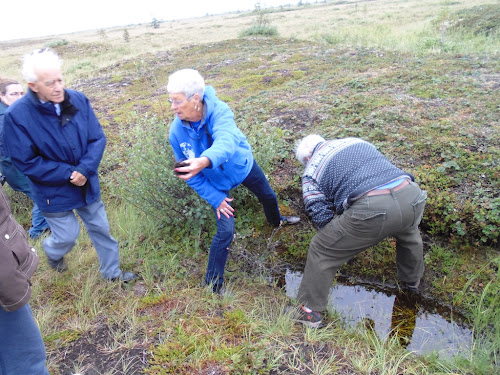Parker and Belinda arranged for a tour bus to take the eight of us (plus some other guests) on a comprehensive excursion encompassing the townsite and surrounding area. Mark was a fantastic guide: a lifelong Churchillian, affable, knowledgeable, and able to give insights on all manner of topics, from history to biology.
Cape Merry Battery - our first stop was the Cape Merry Battery, an artillery position directly across the river from Fort Prince of Wales. Imagine what it must have been like to sit on this lonely spit of rock two and a half centuries ago, keeping one eye on the lookout for French ships and the other open for polar bears. Combining elements of history and scenery made this an ideal first stop, despite the fact it was about 9 degrees and raining. As a bonus, we got to see lots of beluga whales in the river.
St. Paul's Anglican Church - the neatest feature of this old church is the stained glass, much of which came from the military chapel when they closed the base back in the sixties. The pane featuring Saint Michael, "Captain of the Heavenly Hosts" was donated by the U.S. Strategic Air Command, which seems appropriate, if a little chilling. There is also a window donated by Lady Franklin, in thanks and recognition for those who attempted to find her husband's doomed expedition.
Miss Piggy - back in 1979, a twin engine cargo plane tried to return to the Churchill Airport after noticing a problem shortly after takeoff, but caught its tailwheel on a telephone line, and ended up pancaking on these rocks. The pilot and co-pilot both walked away from the wreck, qualifying it as a good landing. After the avionics were stripped out, the wreck was left in place, since it wasn't in the way of anything, removing it would require a lot of effort and resources.
Boreal Forest - we've all seen trees, but there some neat examples around Churchill, like the 'flag trees' with all the foliage stripped off the northern half of the tree by wind and ice crystals. Or the bendy conifer below.
Canadian Eskimo Dogs - when the government moved much of the Inuit population to the coasts and replaced their dog sleds with snowmobiles, many of their sled dogs were shot to prevent them from going feral. Now, the breed is in danger of becoming extinct, so a local man named Brian has taken a group of 70 pf them as breeding stock, and keeps them out of town, which is a necessity as they are a pretty vocal group. They are extremely friendly though, despite how fierce and lupine some of them look.
Permafrost - out at the Northern Studies Centre, Mark pulled over so we could walk on the squashy muskeg, and found a place where you can remove a few handfuls of peat and actually touch the permafrost beneath, which Mum did. Jerry and I were actually more interested in the rocket motor sticking out of the earth about 20 yards away, a remnant from the days when the Churchill Rocket Research Centre was still in operation. We also spied a ptarmigan on our way back out, which is frightfully hard to do since they are so well camouflaged.

















No comments:
Post a Comment